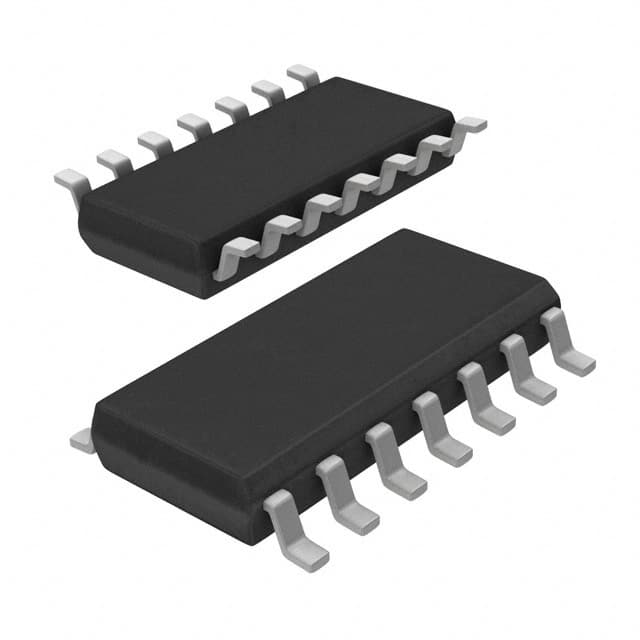Xem thông số kỹ thuật để biết chi tiết sản phẩm.

Encyclopedia Entry: 74AHCT126D,112
Product Overview
Category
The 74AHCT126D,112 belongs to the category of integrated circuits (ICs). Specifically, it falls under the category of digital logic gates.
Use
This product is primarily used for signal amplification and switching in digital electronic circuits. It serves as a quad buffer/line driver with 3-state outputs.
Characteristics
- Quad buffer/line driver
- 3-state outputs
- High-speed operation
- Low power consumption
- Wide operating voltage range
- Schmitt-trigger action on all inputs
Package and Quantity
The 74AHCT126D,112 is available in a small-outline package (SO) with 14 pins. It is typically sold in reels or tubes containing multiple units.
Essence
The essence of the 74AHCT126D,112 lies in its ability to amplify and switch digital signals effectively, while offering high-speed operation and low power consumption.
Specifications
- Supply Voltage Range: 4.5V to 5.5V
- Input Voltage Range: 0V to VCC
- Output Voltage Range: 0V to VCC
- Operating Temperature Range: -40°C to +125°C
- Maximum Quiescent Current: 8µA at 5.5V
- Maximum Propagation Delay: 9ns at 5.5V
Detailed Pin Configuration
The 74AHCT126D,112 has 14 pins, each serving a specific function:
- 1A - Input 1 for buffer A
- 1Y - Output 1 for buffer A
- GND - Ground
- 2Y - Output 2 for buffer B
- 2A - Input 2 for buffer B
- 3A - Input 3 for buffer C
- 3Y - Output 3 for buffer C
- VCC - Positive power supply
- 4Y - Output 4 for buffer D
- 4A - Input 4 for buffer D
- OE - Output enable input (active low)
- NC - No connection
- GND - Ground
- GND - Ground
Functional Features
The key functional features of the 74AHCT126D,112 include:
- Quad buffering capability
- 3-state outputs for high impedance state
- Schmitt-trigger action on all inputs for noise immunity
- Wide operating voltage range for compatibility with various systems
Advantages and Disadvantages
Advantages
- High-speed operation allows for efficient signal processing
- Low power consumption reduces energy requirements
- Schmitt-trigger action enhances noise immunity
- Wide operating voltage range ensures compatibility with different systems
Disadvantages
- Limited number of buffer/line driver channels (4 in this case)
- Not suitable for applications requiring a large number of outputs
Working Principles
The 74AHCT126D,112 operates based on the principles of digital logic gates. It takes input signals from the A, B, C, and D pins, amplifies them, and drives the corresponding outputs Y1, Y2, Y3, and Y4. The output enable (OE) pin controls the activation of the outputs. When OE is low, the outputs are enabled, and when it is high, the outputs enter a high impedance state.
Detailed Application Field Plans
The 74AHCT126D,112 finds application in various fields, including:
- Microprocessor-based systems
- Data communication systems
- Industrial automation
- Automotive electronics
- Consumer electronics
In microprocessor-based systems, it can be used for address and data bus buffering. In data communication systems, it aids in signal amplification and line driving. In industrial automation, it facilitates control signal processing. In automotive electronics, it assists in signal conditioning and interfacing. In consumer electronics, it contributes to digital signal processing and switching.
Detailed Alternative Models
For those seeking alternative models with similar functionality, the following options are available:
- 74HC126: This is a non-inverting buffer/line driver with 3-state outputs.
- SN74LVC126A: A quad buffer/line driver with 3-state outputs, offering low voltage operation.
- CD74HCT126E: Similar to the 74AHCT126D,112, this model provides quad buffering and 3-state outputs.
These alternative models can be considered based on specific requirements and compatibility with the target system.
In conclusion, the 74AHCT126D,112 is a versatile integrated circuit that serves as a quad buffer/line driver with 3-state outputs. Its high-speed operation, low power consumption, and wide operating voltage range make it suitable for various
Liệt kê 10 câu hỏi và câu trả lời thường gặp liên quan đến ứng dụng 74AHCT126D,112 trong giải pháp kỹ thuật
Sure! Here are 10 common questions and answers related to the application of 74AHCT126D,112 in technical solutions:
Q: What is the function of the 74AHCT126D,112? A: The 74AHCT126D,112 is a quad buffer/line driver IC that can be used for signal buffering and level shifting.
Q: What is the operating voltage range of the 74AHCT126D,112? A: The 74AHCT126D,112 operates within a voltage range of 4.5V to 5.5V.
Q: How many buffers/drivers are there in the 74AHCT126D,112? A: The 74AHCT126D,112 consists of four independent buffer/drivers.
Q: What is the maximum output current of each buffer/driver in the 74AHCT126D,112? A: Each buffer/driver in the 74AHCT126D,112 can provide a maximum output current of 8mA.
Q: Can the 74AHCT126D,112 be used for bidirectional communication? A: No, the 74AHCT126D,112 is unidirectional and can only be used for one-way signal transmission.
Q: What is the input voltage threshold for logic high and logic low levels in the 74AHCT126D,112? A: The input voltage threshold for logic high is typically 2.0V, while for logic low it is typically 0.8V.
Q: Can the 74AHCT126D,112 tolerate overvoltage on its inputs? A: Yes, the 74AHCT126D,112 has input protection diodes that can tolerate voltages up to VCC + 0.5V.
Q: What is the propagation delay of the 74AHCT126D,112? A: The propagation delay of the 74AHCT126D,112 is typically around 7ns.
Q: Can the 74AHCT126D,112 be used in high-speed applications? A: Yes, the 74AHCT126D,112 is designed for high-speed operation and can be used in applications with fast signal transitions.
Q: Is the 74AHCT126D,112 compatible with other logic families? A: Yes, the 74AHCT126D,112 is compatible with a wide range of logic families, including TTL, CMOS, and LVTTL.
Please note that the answers provided here are general and may vary depending on specific datasheet specifications and application requirements.

